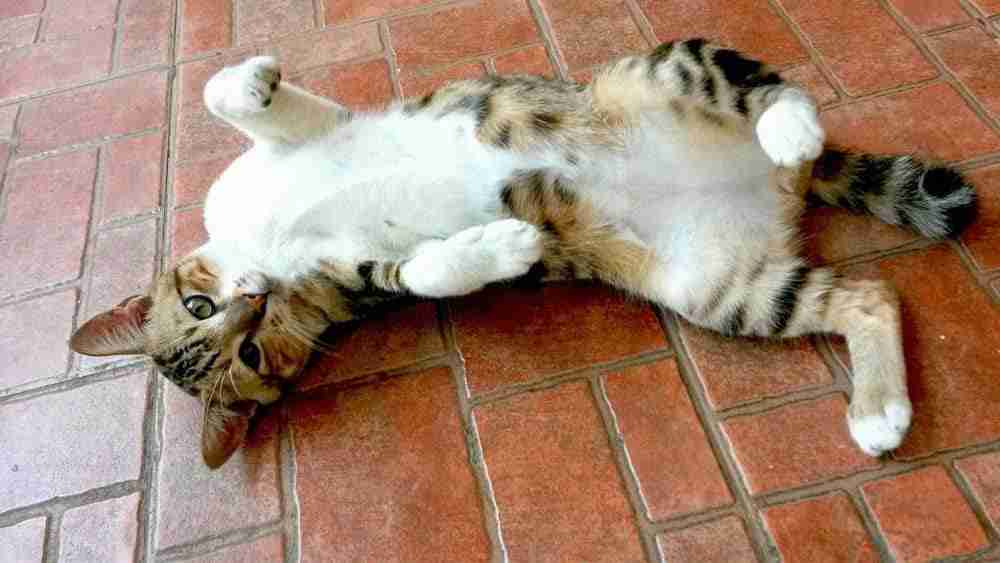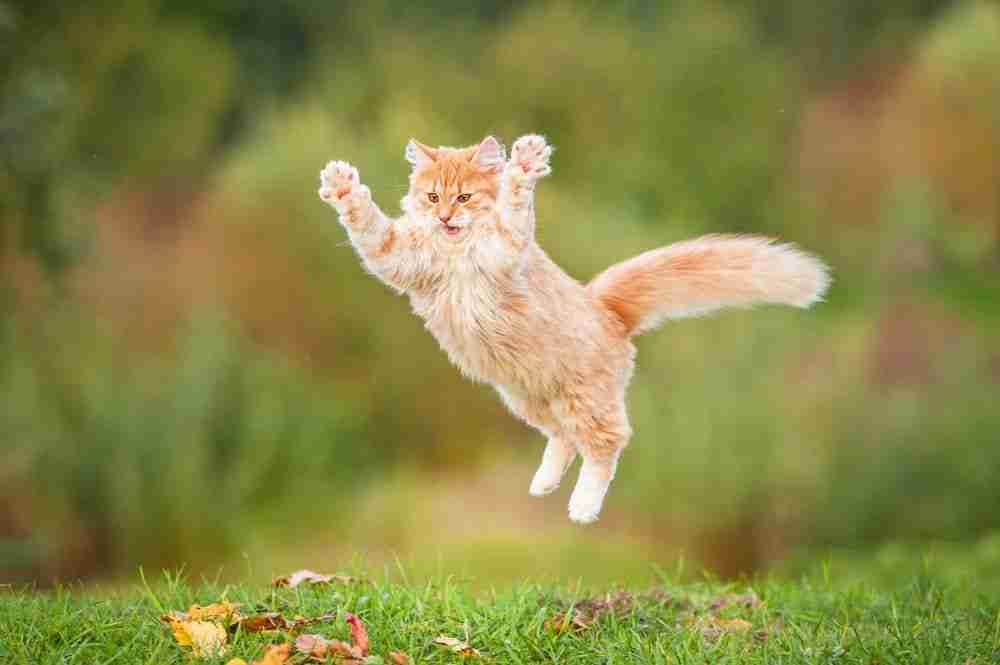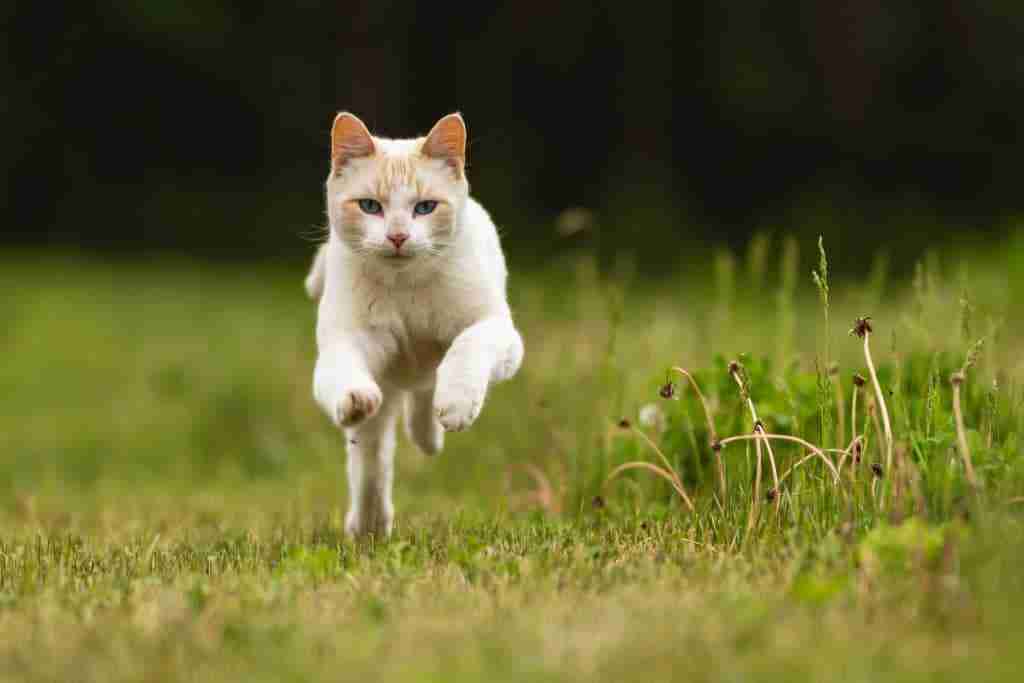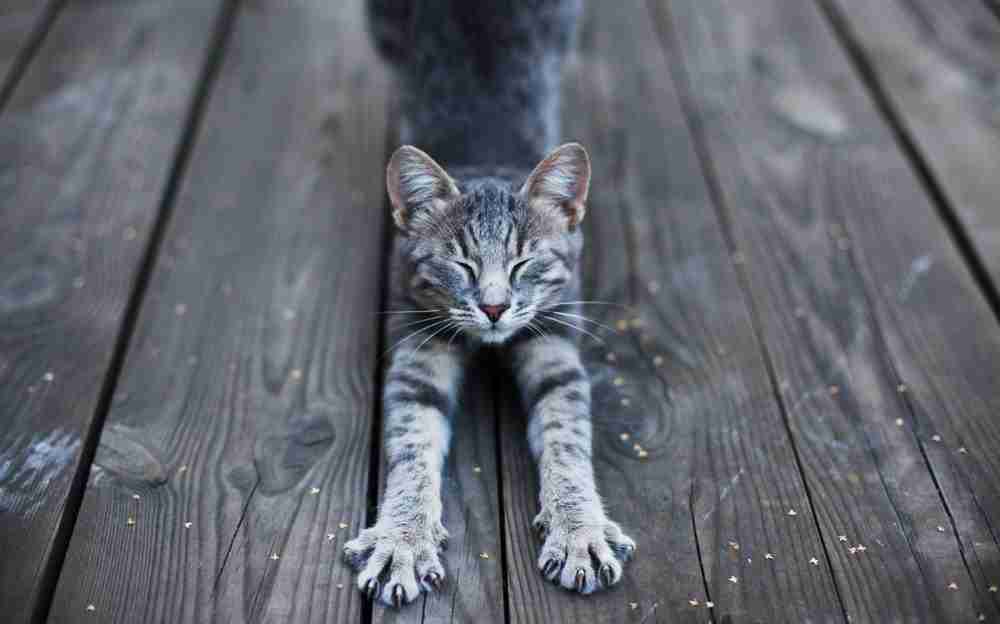How are cats so flexible? Mainly due to unattached collar bones and a super flexible spine. Read on to learn more.
You marvel as your cat and dachshund chase each other around the yard. It doesn’t matter what your dog does; it can’t seem to catch your kitty. From doing backflips off walls to accomplishing quick turns, their speed and movement make your joints twinge just watching the action.
Cats have amazing powers of agility and flexibility. The average house cat moves with the grace of a ballerina and the power of a performance athlete.
They can contort and twist themselves through the slightest gaps, and they always seem to land on their feet. Why are cats the ultimate animal acrobat?

Your Cat – The Natural Acrobat
Most of us know the old wives’ tale that cats always land on their feet (and your toast always lands peanut-butter side down).
However, there’s actually science behind your cat’s midair agility. Felines are one of the few animals that rotate their bodies in midair with speed and precision.
A cat’s reflexes are so quick; that they can flip themselves the right way up in a fraction of a second. Take a second to consider the physiology and the flexibility to turn like that in midair – could you do it?
Most of us can barely manage a backflip, even when we’re in good shape. However, your cat pulls of a full 180-degree turn with no issues – that’s impressive.
So, what’s your kitty’s secret to outstanding flexibility?
Cats have these powers thanks to their lack of attached collarbone in their skeletal structure. They also have an unusually flexible spine that even yoga enthusiasts envy.
Look at your cat when they get up and stretch, and it appears like they have a rubber band for a backbone.

Pouncing on Prey
Cats are masters in flexibility and contortion, in the air and on the ground. Look at any cat family member, from leopards to house cats, and they all have limber, flexible, and agile bodies.
Watch your cat when they’re stalking a bird or mouse in your yard. They position their body low to the ground, retracting their limbs to form a low-profile visual for the prey.
When they have the right range, your cat can pounce on the bird or rat, reaching distances up to nine times its body length.
The housecat’s spine acts as a spring, and its limbs are the coils driving the movement. They extend their limbs out far to seize the prey, and it all happens in a nanosecond before the poor bird or mouse knows what hit it.
Interesting fact:
You might not know it, but unlike dogs, cats’ claws are part of their skeleton. As a result, their claws act more like fingers. It’s for this reason that you should never trim a cat’s claw.
Cats and Cleaning
Watch your cat when they’re grooming, and you’ll get another remarkable display of flexibility.
The cat manages to put itself into some awkward positions that seem impossible; it’s almost like they can fold themselves in half.
Cats twist and turn in ways that boggle our minds, bending around to lick their tailbone effortlessly. Can you reach your foot up to your head? Your cat can do it, and they can clean between their toes.

The Super Spine of a Feline
Cats like to stretch and flex even when they’re not out stalking prey, grooming, or harassing the dog.
Your cat probably enjoys curling up into a tight ball on your lap. Some cats might also lean over the edge of a kitty box, with their spine looking like it folds 270-degrees to the side.
The human spine has between 32 and 34 joints (vertebrae) separated by discs that cushion impact and provide fluid movement.
In contrast, your cat has 52 to 53 vertebrae in their spine, and their total spine length is a third of ours.
Therefore, they have more joints to flex in movements, giving them a wider range of motion when flexing their spine.
Clavicles that Compress for Contorting through Compact Spaces
The second secret of your kitty’s supernatural flexibility is their clavicles. Cats have tiny collarbones that they can collapse when squeezing through tight spaces.
Try to get through a tight space yourself, and you’ll find your shoulders get in the way. However, if you were to dislocate your collarbones, you could slip through easily.
Your cat can do this action naturally. The smaller unattached collarbones mean it can collapse the clavicles, allowing it to squeeze through tiny gaps.
Your cat also has the ability to dislocate its shoulder blades from its skeletal frame. The shoulder blades and small clavicles attach to the skeletal system with muscle and sinew, rather than the joints in humans.
Built for Balance

Along with amazing agility and flexibility, your cat seems to have impeccable balance. Cats can walk along the thinnest walls and tree branches without falling.
The secret to your cat’s outstanding balance is its vestibular system. The vestibular system is deep in the inner ear, providing your cat with sensory perception and orientation.
This sensitive system determines which way is up or down in a fraction of a second. When your cat falls, they interpret this data, drawing their limbs close to their bodies as they twist in midair.
The result is a perfect landing every time. Whether it’s running, pouncing, or having a stroll in the treetops, cats have an amazing sense of balance and total control over their body.
An Evolution of the Perfect Predator Pet
Your typical housecat is far different from its big cat ancestors. However, your kitty owes its genetics to the lineage of big cat predators passed down through thousands of generations of felines.
Cats are obligate carnivores, meaning they need to eat meat to survive. Since most meals are usually alive and kicking, cats evolved super movement skills, speed, and balance to survive.
All housecats come from a line of apex predators, and they display these qualities in their movement, balance, and their attitude.
How are cats so flexible? They have more vertebrates and a longer spine than us and smaller than usual collarbones. These factors give them additional flexibility and a greater range of movement.
As you stare out at fido, trying to get his paws on your cat, you know he has no chance
